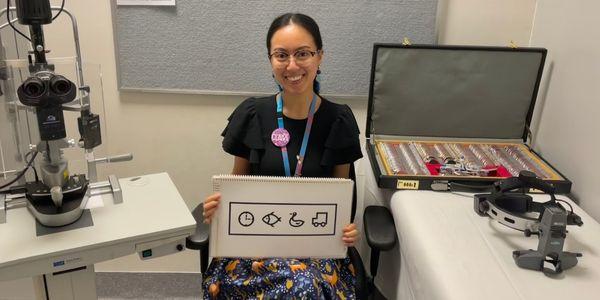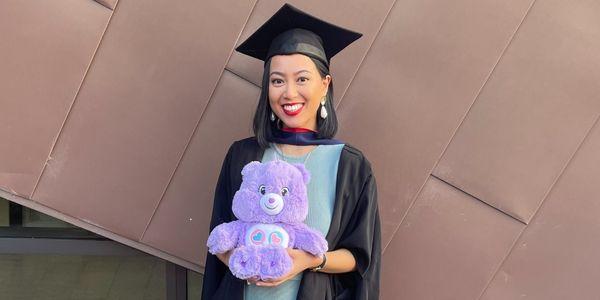2:30min

Since the age of eight, Claire Ong knew that she wanted to be an optometrist. In her youth, where visits to the optometrist for her vision were a regular occurrence, she found herself fascinated with the firsthand impact an optometrist can have on a child.
“Working in practice has shown me how much people value their eyes,” she said. “Being able to provide for others what was provided to me is very rewarding. After wanting to study optometry during high school and eventually studying it at university, I’m glad I was right – Optometry is a very rewarding field to work in.”
Having graduated in 2021, Claire now splits her time between two workplaces, a Specsavers in Sefton Park and the Women’s and Children’s Hospital in Adelaide where she grew up. She spoke at the Flinders University Careers Expo on 21 February, has further engagements in both Adelaide and Melbourne, and has plans to do even more. Optometry Victoria South Australia’s Alex Wisdom managed to find some time in her busy schedule to sit down and ask about how she got here and her bright outlook on optometry.
OV/SA: Have you always wanted to be an optometrist?
Claire: I sure have, since my first eye test at eight years old! I did wonder at times, especially as an optometry student, whether the job itself would be as amazing as I had always imagined it to be, but it is genuinely so rewarding that I couldn’t imagine myself doing anything else. I’m excited to be part of the profession and I really enjoy providing patient care and giving back what I received when I was young.
OV/SA: What kind of work do you do at the Women’s and Children’s Hospital?
Claire: We’re currently in a six-month pilot to see where optometry fits into a paediatric ophthalmology department in a tertiary hospital setting. Ophthalmologists at the Women’s and Children’s work in the paediatric outpatients department, and we see a wide range of both ocular and systemic conditions, in children ranged from 0 to under 18 years of age. It can be intense, and in a hospital setting it’s a side of eye care that’s not commonly seen in a community practice setting, or seen at all.
When I work at the hospital, I have support from a fantastic multidisciplinary team. The team consists of ophthalmologists, registrars, orthoptists, junior doctors, and nurses – they all bring excellent skills and knowledge for us to take the best care of our patients. It’s a different kind of clinical thinking, as many of the children who come in have significant eye issues associated with general health complications. It’s a steep learning curve for me being in this new working environment while seeing a huge variety of new conditions. There are not many optometrists in hospitals around Australia, so I hope that in the future, optometrists are able to use their fantastic skill set as part of a multidisciplinary team to keep providing fantastic patient care.
I still see unusual and complex cases in a community practice setting, but it is usually an assessment for healthy eyes. Optometrists in the community of course play a vital role in in primary health care, including preventative care and early detection of disease, and a key role in educating patients about their eyes.
OV/SA: Is paediatrics the area that most interests you?
Claire: Yes, absolutely. Paediatrics is my passion. My goal is to one day be a trusted advisor to patients and their families, a clinical educator, and a paediatric eye care advocate.
For example, I once had a 13-year-old girl come in for her first eye test. She had no complaints and her parents understandably had no concerns, but when she covered one eye she couldn’t see much. It turned out that she had untreated amblyopia, and both she and her parents were shocked that she had this condition. It went undetected all this time, so as optometrists we all have such an important role in diagnosing and managing diseases, educating patients about their eyes, and advocating for regular eye exams even in patients who don’t seem to have any issues.
I’m privileged to be in a profession where patient care is our foundation. We’re in such an important place in the community; we look after people’s eyes. While it can feel quite routine at times, our role as primary eye care professionals really is something of value. For us, a patient could be one of many in that day, but for them, you are an important contact and maybe someone they’ll remember forever.
OV/SA: What are your hopes for the future?
Claire: I hope to do more advocating and educating, not just to my patients but also to optometry students and community optometrists. I’m passionate about getting involved with optometry students, as it’s so important to get connected and engaged with the next generation of eye care professionals. After speaking at the Careers Expo, I think I’d actually love to do more speaking. Given that I was only two years older than these final year students, I didn’t think I had that much to give, but they really wanted to hear what I had to say. It actually made me a bit nostalgic for my student days!

As for the future of optometry, my hope is that we will move forward together and that we’ll be able to advocate for change as a profession. I’d like to empower and educate community optometrists to feel more confident with assessing and managing paediatric patients. I also hope that in time we will have a network of optometrists both in SA and nationwide who can do this, and that other optometrists can inter-refer when they have paediatric patients who they want to transfer care for.
It’s so important to take the time and care with children and realise just how much we optometrists can help and inspire little kids like my eight-year-old self.
This story was created and shared by OV/SA.
Tagged as: hospitals, Paediatric optometry, profile